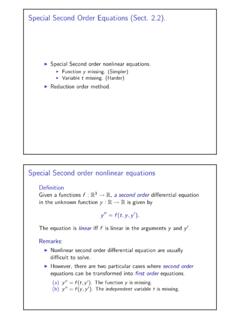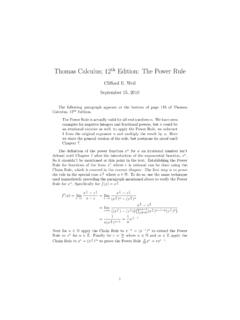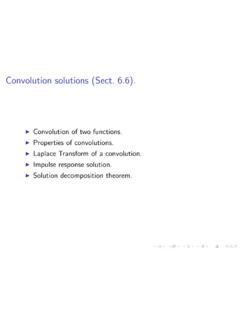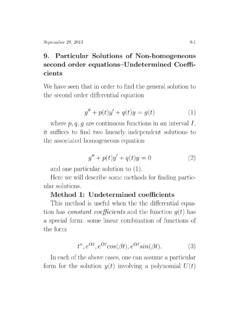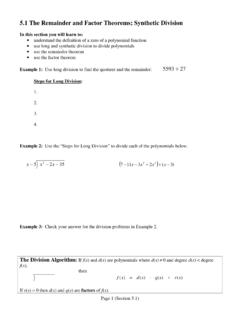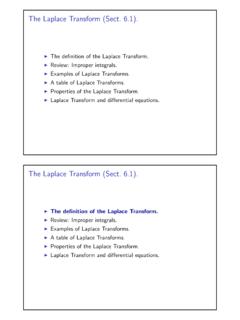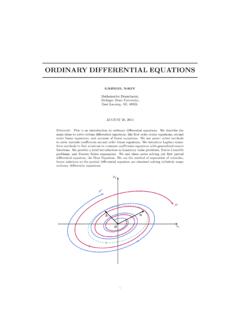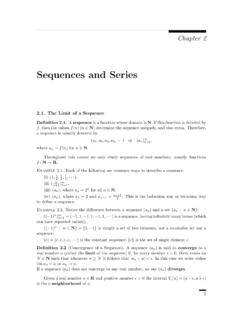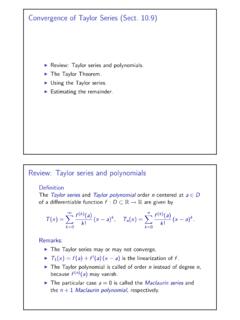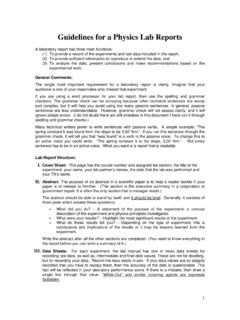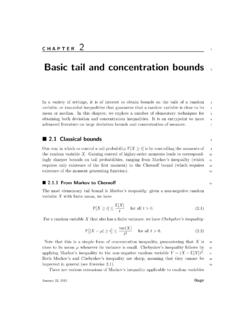Transcription of Premium Calculation - Michigan State University
1 Premium CalculationLecture: Weeks 12-14 Lecture: Weeks 12-14 (STT 455) Premium CalculationFall 2014 - Valdez1 / 31 PreliminariesPreliminariesAn insurance policy (life insurance or life annuity) is funded by contractpremiums:once (single Premium ) made usually at time of policy issue, ora series of payments (usually contingent on survival of policyholder)with first payment made at policy issueto cover for the benefits, expenses associated withinitiating/maintaining contract, profit margins, and deviations due toadverse premiums (or sometimes called benefit premiums)considers only the benefits providednothing allocated to pay for expenses, profit or contingency marginsGross premiums (or sometimes called expense-loaded premiums)covers the benefits and includes expenses, profits, and contingencymarginsLecture.
2 Weeks 12-14 (STT 455) Premium CalculationFall 2014 - Valdez2 / 31 Preliminarieschapter summaryChapter summaryContract premiumsnet premiumsgross (expense-loaded) premiumsPresent value of future loss random variablePremium principlesthe equivalence principle (or actuarial equivalence principle)portfolio percentile premiumsReturn of Premium policiesChapter 6 of Dickson, et : Weeks 12-14 (STT 455) Premium CalculationFall 2014 - Valdez3 / 31 Net random future lossNet random future lossAn insurance contract is an agreement between two parties:the insurer agrees to pay for insurance benefits;in exchange for insurance premiums to be paid by the by PVFB0the present value, at time of issue, of futurebenefits to be paid by the by PVFP0the present value, at time of issue, of futurepremiums to be paid by the insurer s net random future loss is defined byLn0=PVFB0 : this is also called the present value of future loss randomvariable (in the book), and if no confusion, we may simply write : Weeks 12-14 (STT 455) Premium CalculationFall 2014 - Valdez4 / 31 Net random future lossequivalence principleThe principle of equivalenceThe net Premium , generically denoted byP, may be determinedaccording to the principle of equivalence by settingE[Ln0]= expected value of the insurer s net random future loss is is then equivalent to setting E[PVFB0]=E[PVFP0].
3 In otherwords, at issue, we haveAPV(Future Premiums)=APV(Future Benefits).Lecture: Weeks 12-14 (STT 455) Premium CalculationFall 2014 - Valdez5 / 31 Net random future lossillustrationAn illustrationConsider ann-year endowment policy which pays B dollars at the end ofthe year of death or at maturity, issued to a life with exact agex. Netpremium ofPis paid at the beginning of each year throughout the we denote the curtate future lifetime of(x)byK=Kx, then thenet random future loss can be expressed asLn0=Bvmin(K+1,n) P amin(K+1,n).The expected value of the net random future loss isE[Ln0]=BE[vmin(K+1,n)] PE[ amin(K+1,n)]=BAx:n P : Weeks 12-14 (STT 455) Premium CalculationFall 2014 - Valdez6 / 31 Net random future lossillustrationAn illustration - continuedBy the principle of equivalence, E[Ln0]= 0, we then haveP=BAx:n the net random future loss asLn0=(B+Pd)vmin(K+1,n) Pd,we can find expression for the variance:Var[Ln0]=(B+Pd)2[A2x:n (Ax:n)2].
4 One can also show that this simplifies toVar[Ln0]=B2A2x:n (Ax:n)2(1 Ax:n) : Weeks 12-14 (STT 455) Premium CalculationFall 2014 - Valdez7 / 31 Net random future lossgeneral principlesSome general principlesNote the following general principles when calculating premiums:For (discrete) premiums, the first Premium is usually assumed to bemade immediately at benefit may have expiration or maturity:in which case, it is implied that there are no premiums to be paidbeyond expiration or , it is possible that premiums are to be paid for lesser periodthan expiration or maturity. In this case, it will be explicitly : Weeks 12-14 (STT 455) Premium CalculationFall 2014 - Valdez8 / 31 Fully discretewhole life insuranceFully discrete annual premiums - whole life insuranceConsider the case of a fully discrete whole life insurance where benefit of$1 is paid at the end of the year of death with level annual net annual Premium is denoted byPxso that the net random futureloss isL0=vK+1 Px aK+1,forK= 0,1,2.
5 By the principle of equivalence, we havePx=E[vK+1]E[ aK+1]=Ax variance of the net random future loss isVar[L0] =A2x (Ax)2(d ax)2=A2x (Ax)2(1 Ax) : Weeks 12-14 (STT 455) Premium CalculationFall 2014 - Valdez9 / 31 Fully discretewhole life insuranceOther expressionsYou can express the net annual premiums:in terms of annuity functionsPx=1 d ax ax=1 ax din terms of insurance functionsPx=Ax(1 Ax)/d=dAx1 AxLecture: Weeks 12-14 (STT 455) Premium CalculationFall 2014 - Valdez10 / 31 Fully discretewhole life insurance withhpayWhole life insurance withhpremium paymentsConsider the same situation where now this time there are net random future loss in this case can be expressed asL0=vK+1 P { aK+1,forK= 0,1,..,h 1 ah,forK=h,h+ 1,..Applying the principle of equivalence, we haveP=Ax : Weeks 12-14 (STT 455) Premium CalculationFall 2014 - Valdez11 / 31 Fully discreteillustrative examplesIllustrative example 1 Consider a special endowment policy issued to (45).}
6 You are given:Benefit of $10,000 is paid at the end of the year of death, if deathoccurs before 20 of $20,000 is paid at the end of 20 years if the insured is annual premiumsPare paid at the beginning of each year for10 years and nothing follows theIllustrative Life Tablewithi= 6%.CalculatePaccording to the equivalence : Weeks 12-14 (STT 455) Premium CalculationFall 2014 - Valdez12 / 31 Fully discreteillustrative examplesSOA-type questionTwo actuaries use the same mortality table to price a fully discretetwo-year endowment insurance of 1,000 on(x). You are given:Kevin calculates non-level benefit premiums of 608 for the first year,and 350 for the second calculates level annual benefit premiums of .d= .Lecture: Weeks 12-14 (STT 455) Premium CalculationFall 2014 - Valdez13 / 31 Fully discreteillustrative examplesIllustrative example 2An insurance company issues a 15-year deferred life annuity contract to(50).
7 You are given:Level monthly premiums ofPare paid during the deferred annuity benefit of $25,000 is to be paid at the beginning of eachyear the insured is alive, starting when he reaches the age of follows theIllustrative Life Tablewithi= 6%.Mortality between integral ages follow the Uniform Distribution ofDeath (UDD) down an expression for the net future loss, at issue, the amount an additional benefit of $10,000 is to be paid at the moment ofdeath during the deferred period, how much will the increase in themonthly Premium be?Lecture: Weeks 12-14 (STT 455) Premium CalculationFall 2014 - Valdez14 / 31 Different possible combinationsDifferent possible combinationsPremium paymentBenefit paymentannuallyat the end of the year of deathat the end of the1mth year of deathat the moment of deathm-thly of the yearat the end of the year of deathat the end of the1mth year of deathat the moment of deathcontinuouslyat the end of the year of deathat the end of the1mth year of deathat the moment of deathLecture: Weeks 12-14 (STT 455) Premium CalculationFall 2014 - Valdez15 / 31 Fully continuouswhole life insuranceFully continuous premiums - whole life insuranceConsider a fully continuous level annual premiums for a unit whole lifeinsurance payable immediately upon death of(x).
8 The insurer s net random future loss is expressed asL0=vT P the principle of equivalence,P= Ax ax=1 ax = Ax1 variance of the insurer s net random future loss can be expressedasVar[L0] =[1 + (P/ )]2[ A2x ( Ax)2]= A2x ( Ax)2( ax)2= A2x ( Ax)2(1 Ax) : Weeks 12-14 (STT 455) Premium CalculationFall 2014 - Valdez16 / 31 Fully continuouswhole life insuranceA simple illustrationFor a fully continuous whole life insurance of $1, you are given:Mortality follows a constant force of = is at a constant force = the loss-at-issue random variable with the benefit premiumcalculated based on the equivalence the annual benefit Premium and Var[L0].Lecture: Weeks 12-14 (STT 455) Premium CalculationFall 2014 - Valdez17 / 31 Fully continuousSOA questionPublished SOA question #14 For a fully continuous whole life insurance of $1 on(x), you are given:The forces of mortality and interest are constant.
9 A2x= benefit Premium is the loss-at-issue random variable based on the benefit Var[L0].Lecture: Weeks 12-14 (STT 455) Premium CalculationFall 2014 - Valdez18 / 31 Fully continuousendowment insuranceEndowment insuranceConsider ann-year endowment insurance with benefit of $1:The net random future loss isL={vT P aT, T nvn P an, T > nNet annual Premium formulas:P= Ax:n ax:n=1 ax:n = Ax:n1 Ax:nThe variance of the net random future loss:Var[L0]=[1 +(P/ )]2[ A2x:n ( Ax:n)2]= A2x:n ( Ax:n)2( ax:n)2= A2x:n ( Ax:n)2(1 Ax:n)2 Lecture: Weeks 12-14 (STT 455) Premium CalculationFall 2014 - Valdez19 / 31 Additional problemsIllustrative example 3 For a fully continuousn-year endowment insurance of $1 issued to(x),you are given:Zis the present value random variable of the benefit for [Z] = [Z] = annual premiums are paid on this insurance, determinedaccording to the equivalence Var[L0], whereL0is the net random future loss at : Weeks 12-14 (STT 455) Premium CalculationFall 2014 - Valdez20 / 31 Additional problemsIllustrative example 4 For a fully discrete whole life insurance of 100 on (30), you are given: denotes the annual Premium andL0( )denotes the net randomfuture loss-at-issue random variable for this follows theIllustrative Life Tablewithi= 6%.}
10 Calculate the smallest Premium , , such that the probability is less that the lossL0( )is : Weeks 12-14 (STT 455) Premium CalculationFall 2014 - Valdez21 / 31 Life insurance contract expensestypesTypes of Life Insurance contract expensesInvestment-related expenses ( analysis, cost of buying, selling,servicing)Insurance-related expenses:acquisition (agents commission, underwriting, preparing new records)maintenance ( Premium collection, policyholder correspondence)general (research, actuarial, accounting, taxes)settlement (claim investigation, legal defense, disbursement)Lecture: Weeks 12-14 (STT 455) Premium CalculationFall 2014 - Valdez22 / 31 Life insurance contract expensesfirst year vs. renewalFirst year vs. renewal expensesMost life insurance contracts incur large losses in the first yearbecause of large first year expenses:agents commissionpreparing new policies, contractsrecords administrationThese large losses are hopefully recovered in later then do these first year expenses spread over the policy life?
